See also
| Poles |
| ||||||||||
|---|---|---|---|---|---|---|---|---|---|---|---|
| Gorals | |||||||||||
| Kashubians | |||||||||||
| Silesians | |||||||||||
| Other Slavic | |||||||||||
| Germanic | |||||||||||
| Others | |||||||||||
The Lublinians (Polish: Lubliniacy) are a subethnic group of the Polish people, who reside in the historic region of Lesser Poland, in the area of the city of Lublin. They use their own dialect, which belongs to the Lesser Poland dialect of the Polish language. Like most Poles, the Lubliniacy are Roman Catholics.
Polish linguist Jan Stanislaw Bystron claimed that the Lubliniacy should be regarded as a group that belongs to the region of Kresy Wschodnie (Eastern Borderlands), as they resided in areas which had previously been inhabited by Eastern Slavs. Furthermore, the Lubliniacy were under influence of neighboring province of Mazovia. Examples of local architecture and other artefacts are kept at the Museum of Lublin Village in Lublin.
Polish ethnographer Janusz Kamocki divided the Lubliniacy into the following subgroups:

Lesser Poland, often known by its Polish name Małopolska, is a historical region situated in southern and south-eastern Poland. Its capital and largest city is Kraków. Throughout centuries, Lesser Poland developed a separate culture featuring diverse architecture, folk costumes, dances, cuisine, traditions and a rare Lesser Polish dialect. The region is rich in historical landmarks, monuments, castles, natural scenery and UNESCO World Heritage Sites.

Masovian Voivodeship is a voivodeship (province) in east-central Poland, containing Poland's capital Warsaw.

Lubartów is a town in eastern Poland, with 23,000 inhabitants (2004), situated in Lublin Voivodeship. It is the capital of Lubartów County and the Lubartów Commune. Historically it belongs to Lesser Poland.
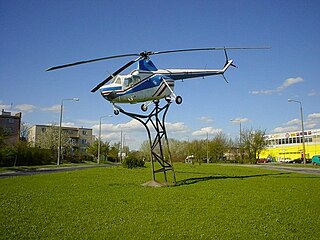
Świdnik is a town in southeastern Poland with 40,186 inhabitants (2012), situated in the Lublin Voivodeship, 10 kilometres southeast of the city of Lublin. It is the capital of Świdnik County. Świdnik belongs to the historic province of Lesser Poland, and was first mentioned in historical records in the year 1392. It remained a village until the end of the 19th century when it began to develop as a spa, due to its location and climate.

Radzyń Podlaskipronounced[ˈrad͡zɨɲpɔdˈlaskʲi] is a town in eastern Poland, about 60 km north of Lublin, with 15,808 inhabitants (2017). The town has been part of the Lublin Voivodeship since 1999, previously it was part of the Biała Podlaska Voivodeship (1975–1998). It is the capital of Radzyń Podlaski County, and historically belongs to the region of Lesser Poland. The town was founded in 1468, and its most important landmark is the rococo Potocki Palace.

Podlachia, or Podlasie (Polish), is a historical region in the north-eastern part of Poland. Between 1513 and 1795 it was a voivodeship with the capital in Drohiczyn. Now the part north of the Bug River is included in the modern Podlaskie Voivodeship with the capital in Białystok.

Forests cover an estimated 38.5% of Poland's territory, and are mostly owned by the state. And are increasing at a fast rate by 2035 Polands forest percentage will be 42-46%. Western and northern parts of Poland as well as the Carpathian Mountains in the extreme south, are much more forested than eastern and central provinces. The most forested administrative districts of the country are: Lubusz Voivodeship (60,2%), Subcarpathian Voivodeship (58,2%), and Pomeranian Voivodeship (50,1%). The least forested are: Łódź Voivodeship (36%), Masovian Voivodeship (34,6%), and Lublin Voivodeship (32,8%).

Cieszyn Silesia, Těšín Silesia or Teschen Silesia is a historical region in south-eastern Silesia, centered on the towns of Cieszyn and Český Těšín and bisected by the Olza River. Since 1920 it has been divided between Poland and Czechoslovakia, and later the Czech Republic. It covers an area of about 2,280 square kilometres (880 sq mi) and has about 810,000 inhabitants, of which 1,002 square kilometres (387 sq mi) (44%) is in Poland, while 1,280 square kilometres (494 sq mi) (56%) is in the Czech Republic.

Pokuttia, also known as Pokuttya or Pokutia, is an historical area of East-Central Europe, situated between the Dniester and Cheremosh rivers and Carpathian Mountains, in the southwestern part of modern Ukraine. Although the historic heart of the area was Kolomyia, the name itself is derived from the town of Kuty that literally means 'round the corner'. The region is now inhabited mainly by Ukrainians.

Bełżyce is a town in eastern Poland, in the Lublin Voivodeship, in Lublin County, and about 20 km (12 mi) to the west of the city of Lublin. Bełżyce belongs to the historical region of Lesser Poland. As of December 2021, the town has a population of 6,290.
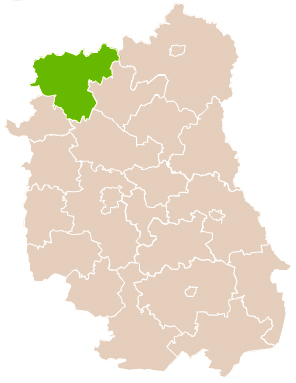
Łuków County is a unit of territorial administration and local government (powiat) in Lublin Voivodeship, eastern Poland. It was established on January 1, 1999, as a result of the Polish local government reforms passed in 1998. Its administrative seat and largest town is Łuków, which lies 76 kilometres (47 mi) north of the regional capital Lublin. The only other town in the county is Stoczek Łukowski, lying 30 km (19 mi) west of Łuków.

Bochotnica is a village in the administrative district of Gmina Kazimierz Dolny, within Puławy County, Lublin Voivodeship, in eastern Poland. It lies in historic province of Lesser Poland, approximately 3 kilometres (2 mi) north-east of Kazimierz Dolny, 10 km (6 mi) south of Puławy, and 42 km (26 mi) west of the regional capital Lublin. The village is located on the right bank of the Vistula, on the road between Puławy and Kazimierz Dolny. The ruins of a 14th-century castle are located nearby.
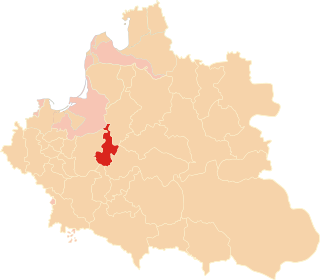
The Podlaskie Voivodeship was formed in 1513 by Sigismund I the Old as a voivodeship in the Grand Duchy of Lithuania, from a split off part of the Trakai Voivodeship. After Lithuania's union with the Kingdom of Poland in 1569 and formation of the Polish–Lithuanian Commonwealth, the voivodeship was transferred to the Polish Crown, where it belonged to the Lesser Poland Province of the Polish Crown.

Lublin Voivodeship was an administrative region of the Kingdom of Poland created in 1474 out of three eastern counties of Sandomierz Voivodeship and lasting until the Partitions of Poland in 1795. Together with Sandomierz Voivodeship and Kraków Voivodeship, it was part of historic Lesser Poland. Lublin Voivodeship had two senators in the Senate of the Kingdom of Poland: the Voivode and the Castellan of Lublin. Local sejmiks took place in Lublin.
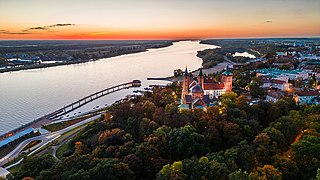
Mazovia or Masovia is a historical region in mid-north-eastern Poland. It spans the North European Plain, roughly between Łódź and Białystok, with Warsaw being the unofficial capital and largest city. Throughout the centuries, Mazovia developed a separate sub-culture featuring diverse folk songs, architecture, dress and traditions different from those of other Poles.

National costumes of Poland vary by region. They are typically not worn in daily life but at folk festivals, folk weddings, religious holidays, harvest festivals and other special occasions. The costumes may reflect region and sometimes social or marital status.
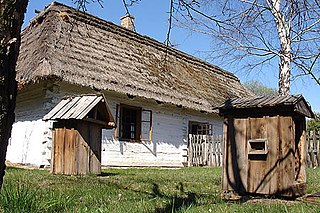
Lasovians are a subethnic group of the Polish nation, who reside in Lesser Poland, at the confluence of the Vistula and the San rivers, Subcarpathian Voivodeship, southeastern Poland. They are descended from various ethnic groups, which settled in the dense Sandomierz Forest across centuries, with a dominant Polish element. The Lasowiacy were formed as a separate subethnic group in the late 19th and early 20th century. They use their own dialect, which belongs to Lesser Polish dialect cluster of the Polish language. Like most Poles, the Lasowiacy are Roman Catholics.

The second Mongol invasion of Poland was carried out by General Boroldai (Burundai) of the Golden Horde in 1259–1260. During this invasion the cities of Sandomierz, Kraków, Lublin, Zawichost, and Bytom were sacked by the Mongols for the second time.
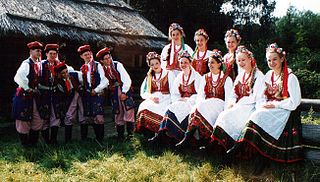
Cracovians are an ethnographic subgroup of the Polish nation, who resides in the historic region of Lesser Poland around the city of Kraków. They use their own dialect, which belongs to the Lesser Polish dialect cluster of the Polish language, and are mostly Roman Catholic.
The Sandomierzacy are a ethnographic group of the Polish nation, who reside in the historic province of Lesser Poland, around the town of Sandomierz. They use their own dialect, which belongs to Lesser Polish dialect of the Polish language. Like most Poles, the Sandomierzacy are Roman Catholics.